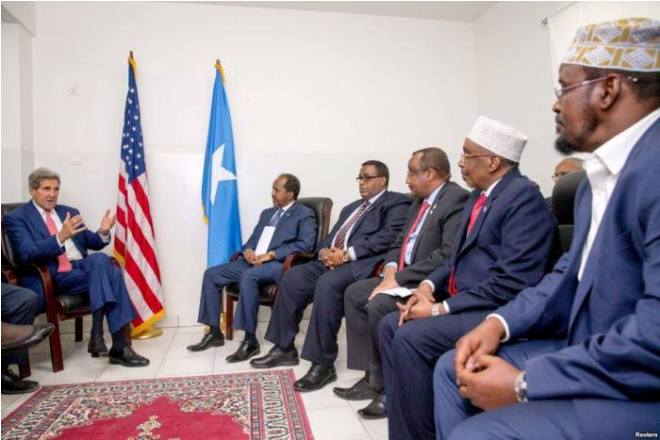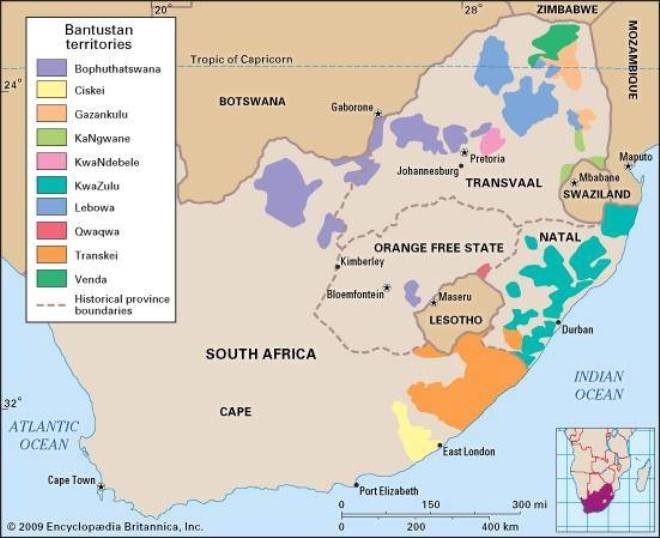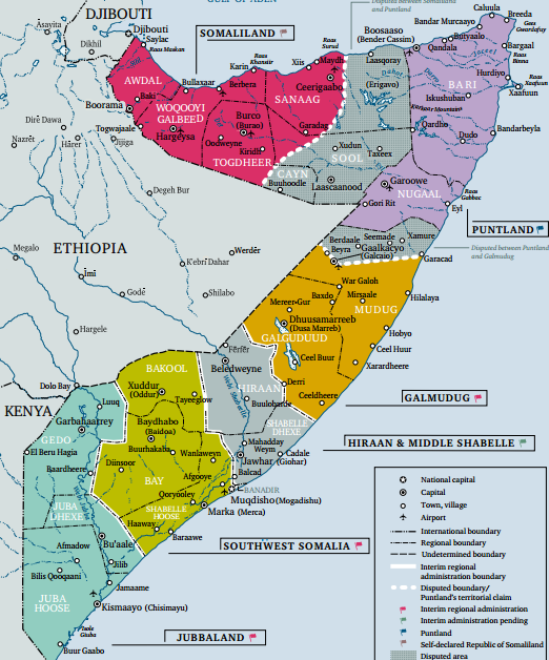Source: DCI
Monday December 12, 2016
 SOMALIA: The South Africa Connection
SOMALIA: The South Africa ConnectionEuphemism in politics, naming things deceptively to hide their true nature, is an age old tactic used whenever a regressive policy is instituted and those in power don’t like for the truth to be known. That is when a colorfully deceptive title like ‘ethnic homeland’ is conjured up to conceal a much more brutal reality. In this short article, a simple juxtaposition of the Bantustans of apartheid South Africa and today’s ‘federal member states’ in Somalia will be presented and the reader will be left to draw their own conclusions.
WHAT IS BANTUSTAN??

When white Europeans arrived on the shores of South Africa, Bantu was the name they gave to the native black people of the land. Once the whites set up their own colonies and later state of South Africa, they decided to implement a policy called Apartheid. According to the apartheid strategy of South Africa in which the aim was to separate whites and blacks, 18 million blacks, 71% of South Africa’s total population, had been allocated 14% of the land fragmented into 10 Bantustans. Every black person would be forced to accept citizenship of a Bantustan. That would deprive them of all citizenship rights in the rest of South Africa and they would only be tolerated as a ‘guest worker’, living in the Bantustan and entering South Africa as a migrant laborer.
In the implementation of this master plan between 1950-1980, roughly 2 million black people were uprooted from their homes in ‘white’ South Africa and dumped in Bantustan relocation camps. With no food, work, or means to earn a living the result was starvation in a slow but sure process of extinction through deliberate government policy. As is clear from the map, the whites got 86% of the country, even though they constituted a tiny minority of the population and the blacks got 14% of the land in their own country. Of the 10 Bantustans, 4 would be designated by the South African government as ‘independent nations’ even though no country in the world recognized this. The remaining 6 were set to receive ‘partial autonomy’ from South Africa meaning in practical terms that the whites would control them.
Central to the white apartheid government’s idea of creating Bantustans was the concept of “original homes” of the black peoples of South Africa. When the National Party came to power in 1948, Minister for Native Affairs, and later Prime Minister of South Africa, Hendrik Frensch Verwoerd built on this, introducing a series of measures that reshaped South African society such that whites would be the demographic majority. The creation of the homelands or Bantustans was a central element of this strategy, as the long-term goal was to make the Bantustans independent. As a result, blacks would lose their South African citizenship and voting rights, allowing whites to remain in control of South Africa.
The term ‘Bantustan’ itself was at first used by the apartheid’s apologists but was later abandoned by the National Party in favour of ‘homelands’. Verwoerd argued that the Bantustans were the “original homes” of the black peoples of South Africa. In 1951, the government of Daniel Francois Malan introduced the Bantu Authorities Act to establish “homelands” allocated to the country’s black ethnic groups. These amounted to 13% of the country’s land, the remainder being reserved for the white population. The homelands were run by cooperative tribal leaders (as seen in the cover photo), while uncooperative chiefs were forcibly deposed. Over time, a ruling black élite emerged with a personal and financial interest in the preservation of the homelands. While this aided the homelands’ political stability to an extent, their position was still entirely dependent on South African support.
WHAT IS QABILISTAN??

In the late 80s, tribal-based opposition to the 21 year regime of Siad Barre had taken up arms against the state. The regime retaliated brutally but was unable to quell the uprising and the opposition finally managed to overrun the capital, Mogadishu, in 1991. In the battle for the capital the government of Somalia was overthrown. The loose alliance of rebel groups then turned on each other over who would rule the country and after a destructive civil war neither of the factions was able to come out on top. In this process, the opposition groups splintered into clan militias that effectively brought down the state in the wake of their merciless bid for power. After a decade of this slow, grinding, on-and-off conflict, by the late 90s the militias had fractured into competing warlords who carved out their respective territories. The state absent and Somalis weak, tired, and divided after a decade of war, the country was essentially ripe for the picking. As the line goes, ‘united we stand, divided we fall’. Somalia did fall. Enter the foreign actors.
The failed intervention of the early 90s by the US/UN, exemplified by the Black Hawk Down incident which finalized their withdrawal from Somalia in 1995, now underwent a rebranding and reorganization. Instead of direct American and European intervention, responsibility would be shifted to Somalia’s two large neighbours, Ethiopia and Kenya, who saw their hand greatly strengthened by an international community that gave them blank cheque to engineer Somalia’s future.
The two east African powers, with a collective population of 130 million compared to Somalia’s 12 million, wasted no time and convened two conferences which produced a Transitional National Government (2000) in Arta, Djibouti and, when it failed to take hold, a Transitional Federal Government (2004) in Mbghathi, Kenya. Two major innovations came out of this Ethiopian and Kenyan led attempt to reconstitute the Somali state. Neither of them would bode well for Somalia’s future. Perhaps, unsurprisingly, they worked very well for Ethiopia and Kenya.
First, the Somalis would be divided according to their Qabiil (clan) in a purported power sharing mechanism dubbed the ‘4.5 clan formula’. Essentially, 4 ‘major’ clans and 5 ‘minor’ ones would divvy up representation in this new government according to the formula. Second, the government would be ‘federal’ one. According to this policy, federal states (of which there was nominally only one in existence at that time) would govern in the regions alongside the federal government which would be based in Mogadishu.
By error, or by design, ultimately, the two proposals came to mesh, forming the new basis for government in Somalia: the clan-state. Newly legitimized warlords, who ravaged the country in the 90s, were now minted ‘parliamentarians’ and got to work drumming up support in the familiar institution of the Qabiil (clan), which ironically was the cause of Somalia’s demise in the first place. Almost overnight, a preponderance of ‘federal states’ were formed. In reality though, the lofty title was nothing more than a thin veneer for the clan based nature of these Ethiopian and Kenyan creations.
Hurriedly, violently, and with the help of no less than an Ethiopian (2006) and Kenyan (2011) military invasion, each ‘federal state’ crowned its president, drew up a flag, claimed its borders, and, egged on and encouraged by Ethiopia and Kenya, behaved belligerently against the ‘’Qabilistan’ next over. With the bloody memory of the civil war still fresh in the minds of the generation that took up leadership in each ‘Qabilistan’, the inevitable result was a renewed wave of conflict as the ‘federal states’ were really just a thin veil for the old clan rivalries. Scores would be settled.
As this unraveling took place, stealthily and under the pretext of ‘conflict mediation’ Ethiopia and Kenya managed to gain powerful control over the country politically, economically, and militarily. Ethiopia, as evidenced by statements of its then leader Meles Zenawi, is keen on a land grab and already has secured lopsided trade deals with its use of Somalia’s sea-ports, especially in Somaliland. Kenya, in a brazen move, apportioned itself a huge chunk of Somalia’s territorial waters, with the signature of Jubaland (which it created) that are believed to contain billions of dollars worth of oil reserves. Unless the tide is turned, the wave of Ethiopian and Kenyan domination will engulf the country and in a decade or two Somalia, now an empty shell of ‘Qabilistans’ will be annexed.
In such a scenario, which many a prominent Somali statesmen, historian, and intellectual has predicted and Ethiopia and Kenya have made no secrets about, can you imagine what it would be like to live in a Qabilistan? To answer that question, you really have to look no further than the Bantustans of South Africa.
Diaspora Consulting International